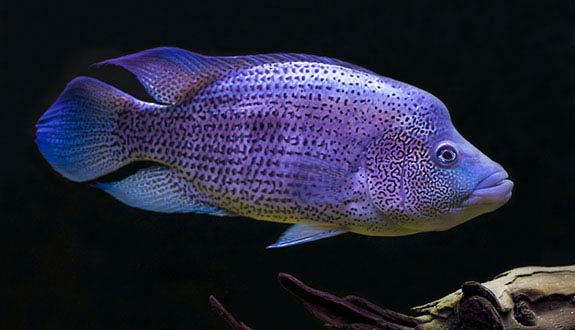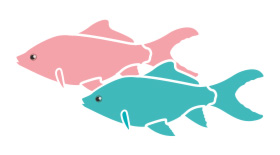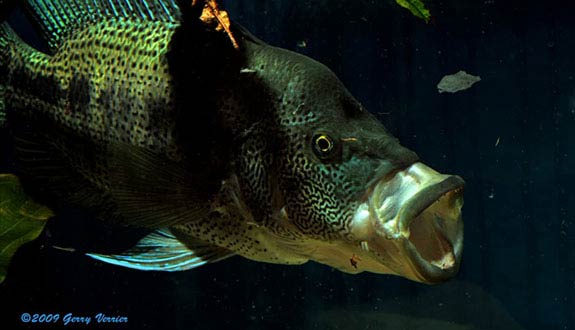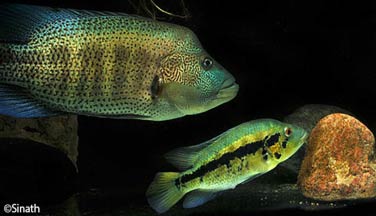

Wolf cichlid
(Parachromis dovii)

A big thank you to Imex Cichlidé!
Alternative species (click on the thumbnail to see the card)
Names
Scientific name
Parachromis Dovii
Common name
Wolf cichlid
Guapote
Rainbow bass
Origin

Origin: Central America (Nicaragua, Honduras, Costa Rica)
Biotope: American
Dimorphism

The male has a multitude of small dark spots, especially on the head (especially on the cheeks). One can note a difference in morphology very important (see "to know").
Group

Cichlidae
Volume

1500 L / 330 imp gal / 400 US gal in specific
Parameters

T°: 24 à 28°C or 75 to 82°F
pH: 7 to 8
Hardness: /
Difficulty

Hard
Size

Female 30/40cm (12/16") - Male 50/70cm (20/28")
Longevity

15 years
Living zone

Everywhere
Individuals

2 (couple)
Food
How to feed the Wolf cichlid?
Food
How to feed the Wolf cichlid?
The Dovii is by nature piscivorous (which eats fish) and carnivorous. Voracious predator, in its original biotope it hunts for small fish, aquatic invertebrates and insects.

In aquarium it eats almost all types of food: granulated or stick, seafood, mold and small frozen fish.
Its basic diet should consist of high protein cichlid pellets and can be varied regularly with live and frozen foods.
Behavior
What kind of behavior does the Wolf cichlid have?
Behavior
What kind of behavior does the Wolf cichlid have?
Dovii is considered one of the (if not the) most aggressive cichlids.
Cohabitation
Who can live with the Wolf cichlid?
Cohabitation
Who can live with the Wolf cichlid?
The Dovii can not stand to be dominated it will often be the «boss» of your aquarium that’s why you cannot put any fish with it!
For roommates, choose a selection of the most aggressive cichlids (Vieja, other Parachromis, Petenia, Amphilophus, etc...).
A 350 x 120 cm or 140 x 50 inch tank (front x width) is a minimum for long-term cohabitation.
The aquarium will have to be slightly overpopulated to prevent it from slaughtering the other inhabitants of the aquarium.
Breeding
How to breed the Wolf cichlid?
Breeding
How to breed the Wolf cichlid?
The female usually lays on a flat rock and it is very good at handling fry while the male protects the nesting area.
Its aquarium
Which aquarium for the Wolf cichlid?
Its aquarium
Which aquarium for the Wolf cichlid?
For a specific aquarium a 250 x 80 cm or 100 x 30 inch tank (front x width) will be ideal for an adult couple. However for a community aquarium, you would have to aim for a 350 x 120 cm or 140 x 50 inch tank.
For the soil, opt for a non-cutting substrate sand because this fish likes to dig in the ground. It must be avoided that it gets hurt during this activity.
For the decor, mimic its natural environment composed of stones, roots and sand. The ideal aquarium will also include hiding places made of stone. No plant should be added under penalty of seeing it mixed and crushed after a short time.
To avoid any pollution, change the water of your aquarium regularly: a renewal of 10% of the total volume will be necessary each week. Also plan a filtration of at least 5x the volume of your tank per hour to obtain a quality water.
Tip: Adding Pothos and external filtering plants will be very useful for keeping nitrates low. Indeed, these plants will consume the nitrates and thus keep a good quality water. This will allow you to change only 10% of the volume per week (which is already 150 liters or 33 Imp Gal or 40 US Gal for the specific aquarium). Without these plants, the amount of water to renew is much higher (30%), as well as your water bill! So do not hesitate to use them if you want to avoid selling your aquarium to pay your water bill.
Good To know
Find all additional information!
Good To know
Find all additional information!
The water parameters are very secondary for this type of species, tolerant enough in this area. However, care must be taken to ensure its good quality and cleanliness.
The male is more colorful, bigger, more massive, longer and his fins are longer. The female is easily recognized: she is smaller, more stocky and her dress is yellow gold:

Yours photos!
Comments
Sort by:
Please login to post comments
